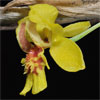|
|
|
|
| Register Yourself at Meyers Conservatory |
To register yourself with the Meyers Conservatory web site, please click the button
below and follow the instructions. You may just make a simple registration with your
email address and a password, but to use the advanced features like the Wish List
you should follow the registration process all the way into the User Information Page
where you can specify plants you are interested in and decide what kind of notifications
you will get.
|
|
|
|
|
| |
Flasks of
Lockhartia lunifera 'Blanco 3219' × self |
|
| |
|
|
| |
| Number: |
TN6953 |
| Name: |
Lockhartia lunifera 'Blanco 3219' × self
|
| Type: |
self (What's that?) |
|
Seed Donor: |
Mario Blanco
|
|
Click to Enlarge

Pod Parent Flower |
|
|
|
| |
Culture Notes from Donor: Parent plant: Temperature range CI (58-75°F)
Comments: Parent plant: Small plant.
For additional origin/habitat information supplied courtesy of
Charles and Margaret Baker, see further below, near the bottom of this page.
|
Temperatures we attempt to use in the lab & greenhouse:
| For Species: |
|
Spring, Summer, Autumn: days average 84°F, nights 71°F; best fit is Warm 90-70°F
(Source:
Baker's Web OSC) |
| For Species: |
|
Winter: days average 74°F, nights 62°F; best fit is Cool-Intermediate 75-58°F
(Source:
Baker's Web OSC) |
|
About the name...
| Etymology of |
Lockhartia |
|
Named for English botanist David Lockhart, first director of the Botanical Garden in Port Of Spain, Trinidad (Lesser Antilles) during the 19th century.
(Source:
Mayr & Schmucker 1998) |
| Etymology of |
lunifera |
|
From Latin "lunifer" carrying a (crescent or half) moon.
(Source:
Mayr & Schmucker 1998) |
| Pronunciation of |
Lockhartia |
|
lok-HART-ee-ah
(Source:
Hawkes 1978) |
| Pronunciation of |
lunifera |
|
loo-NI-fe-ra
(Source:
Hawkes 1978) |
|
If you would like to direct someone to this web page, please copy and paste this URL into your email:
http://troymeyers.com/d?016953
| Flask Information |
| Availability: |
We have sold all of the flasks for this item. |
| You should: |
Consider getting individual plants or compots instead of a flask.
See if we have plants available in the greenhouse. |
| Yield Estimate: |
188 plants (based on flask surveys done 05/18/2010 through 07/03/2013)
|
| Plantlet Sizes: |
From many flasks 0.3 - 55 mm plants (based on flask surveys done 05/18/2010 through 09/26/2011)
From one most recently surveyed flask 30 - 55 mm (09/26/2011)
|
|
You might also want to:
|
View the seed assay for this item.
See if we have plants available in the greenhouse.
View items of the same species.
View items of the same genus.
|
| Ordering Information |
| You are not currently logged in. |
|
You must be a registered user and be logged in to reserve a flask or place a notification request. Please log in:
|
|
| Register Yourself at Meyers Conservatory |
To register yourself with the Meyers Conservatory web site, please click the button
below and follow the instructions. You may just make a simple registration with your
email address and a password, but to use the advanced features like the Wish List
you should follow the registration process all the way into the User Information Page
where you can specify plants you are interested in and decide what kind of notifications
you will get.
|
|
|
|
|
|
|
|
| |
The origin/habitat information below is supplied courtesy of Charles and Margaret Baker
The following information is based on the name of the plant provided by the donor, and assumes that the name is correct. If the plant has been misidentified, then the following information may not be correct.
This text is copyrighted by the Bakers and may not be reproduced without permission.
ORIGIN/HABITAT: Brazil. Plants usually grow in the hot, humid lowlands of
Amapá and Pará as well as the warmer lowlands of the States of Espírito
Santo, Rio de Janeiro, São Paulo, Santa Catarina, and Rio Grande do Sul,
but they are occasionally found in the cooler mountains. Specific habitat
elevations were not reported, so the following climate table and cultural
suggestions are based on estimated elevations and should be used somewhat
cautiously.
More about this information and the Bakers...
|
|
|
| |
|
|
|